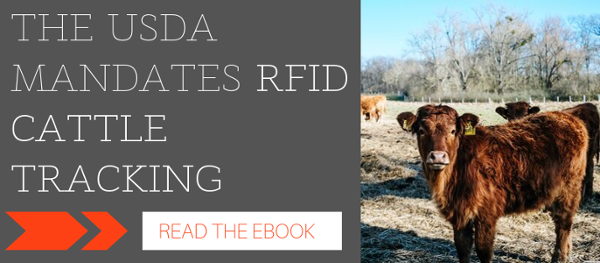RFID Cattle Tracking: How the USDA Mandate is Changing Cattle Tracking in the United States
Introduction
The United States Department of Agriculture ( USDA) was created by President Abraham Lincoln in 1862 to manage, innovate, conserve, and improve agriculture in the United States. One of fifteen Executive Departments in the US government, the USDA plays a major role with regard to farming, livestock, and food both produced in, and imported to, the United States.
The USDA creates and manages guidelines in industries relating to, and impacting, the environment and agriculture – ranging from animals and farming to biotechnology, conservation, and recreation. Agriculture is the most exported, and therefore highest earning, commodity in the United States.
In 2018, beef exports alone grew by an unprecedented 10.7%, while pork and chicken exports each grew by over 4%. Because of the strength of the US market in terms of livestock and livestock products, it is critical for the USDA to maintain standards in the industry to ensure that sales and exports remain high. (1)
To maintain the health of the livestock industry, the USDA has multiple mandates and regulations regarding the health and safety of US livestock. For example, there are mandated vaccines for different types of livestock, National Veterinary Accreditations' for taking care of livestock, and mandated yearly research conducted on the health and maintenance of the US livestock population.
One factor that can have a devastating effect on livestock population is contagious disease. History has shown that contagious diseases like Foot and Mouth Disease (FMD) can lead to the loss of millions of animals. In 2001, in the UK alone, 2,026 official cases led to the killing of 6 million cows and sheep in an effort to contain the spread of the disease.
Epidemics, or epizootics*, like the FMD outbreak in 2001, can devastate a country’s livestock population for years, and are increasingly hard to contain once they begin. Contagious diseases are catastrophic to the livestock industry because of the high frequency of buying, selling, and trading of animals, as well as the highly-contagious nature of some animal diseases.
Previous initiatives by the USDA focused on preventing disease through vaccine, as well as what to do in the case of an outbreak; but, in 2013, the USDA took the next step and created the Animal Disease Traceability Program, or ADT. The ADT Program’s goal is to create individual animal traceability so that, if an outbreak occurs, the animal’s movement can be traced back immediately and the spread of disease contained.
So where does RFID come in?
In order to provide accurate and effective individual traceability – automating the capture of animal data is the key.
The ADT Program, under the USDA, has mandated that, by 2023, RFID ear tags will be the standard form of identification for livestock. The frequency range and type of tag will be dependent on the specific industry or farmer, but all three main RFID frequency types - LF, HF, and UHF – are currently being used for cattle tracking and identification.
Ideally, all livestock (under USDA guidelines*) will have RFID ear tags applied at birth or upon traveling. Each animal will be assigned a unique identification number which will be associated to an RFID tag, and the animal’s veterinary records (in addition to other data, such as RFID tag reads at various stages and locations) will be captured and stored in a national database.
Additionally, travel documentation as well as sale records can be electronically uploaded to provide further information about individual animal. In the case of a disease outbreak, the data can be used to help pinpoint which animals came from where and help officials make informed decisions to contain the outbreak.
Conclusion
For more information on the USDA’s mandate, as well as how farmers/providers can leverage RFID technology to automate daily, weekly, or yearly manual processes - checkout our extensive guide on RFID Livestock Tracking.
Included are several additional RFID applications that owners can implement in their locations to help simplify herd management. Remember to comment below or contact us for more information on RFID ear tags and Livestock Tracking with RFID.
If you would like to learn more about all things RFID, check out our website or our YouTube channel.
To learn more about RFID animal tracking, check out the links below!

Clarifications & Citations
*Epizootic - denoting or relating to a disease that is temporarily prevalent and widespread in an animal population. (dictionary.com)
*USDA Regulations include animals:
- Beef Cattle & Bison that are either – sexually intact and 18 months or older, used for rodeo or recreational events at any age, and used for exhibition and event
- Dairy Cattle that are either – Female cattle, or Male cattle born after 3/11/13 (USDA.gov)
